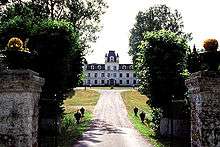Passion Play of Stora Bjurum

The Passionsspelen på Stora Bjurum (The Passion Plays at Stora Bjurum) is a name for a famous incident in Sweden in 1738-1741, when the manor Bjurum in Västergötland became the center of a religious dissident sect. The dissident group was given support of the owner of the manor, countess Eva Margareta Stenbock. The movement excluded themselves from the church and practiced a form of socialism. In 1738, they were subjected to an investigation on behalf of the church, and the name of the incident refers to the passion play in which the female preacher Dordi Olofsdotter acted in the part of Christ. The movement was suppressed after Eva Margareta Stenbock subjected to reuniting with the church in 1741.
Movement
The origin of the incident at Stora Bjurum was a movement founded in Vänersborg by a priest by the name of Lenberg some years before. The movement disliked the church and focused on a personal, internal religious service and interpretation of the bible. This teleology reached the parish of Bjurum with to female preachers from Främmestad: Kerstin Andersdotter and Dordi Olofsdotter. The Stora Bjurum was at the time owned by major count Erik Fredrik Stenbock (1686-1739), though the actual manager of the estate was his spouse, Eva Margareta Clerck (d. 1743). Eva Margareta Clerck became a follower of the movement, and gave its congregation refuge at the estate, which made Stora Bjurum the center of the cult. Among the members of the movement who came to Bjurum because of this were the dissident priests Nils Nabbelius and Sven Hulthén, the last of whom also opened a school there. Eva Margareta Clerck also encouraged the population in the surrounding countryside to join the movement with all sorts of privileges.
Investigation
These activities were in fact illegal according to the then exciting law, konventikelplakatet, which banned private sermons. On 28 February 1738, Stora Bjurum was investigated by the authorities and a delegation from the consistory led by the vicar Sven Holmvall, who filed a report to the authorities.
According to the report, the members of the congregation lived in Stora Bjurum manor house. Many of them was reportedly sick and bedridden upon his arrival, but while he was there, the sick were miraculously cured by the dissident vicar Nils Nabbelius. Some of the sick reacted by convulsions, Religious ecstasy and condemnations of the clergy. It was pointed out, that siblings of opposite gender shared beds, and implied that the members of the congratulation participated in extramarital sex. Some of the members had vandalized the local church in Mårby, and one of them, Alita Sundberg, a female relative and ladies companion of the countess, had performed a sexual act by the church altar. Holmvall also witnessed a Passion Play, were a female, the female preacher Dordi Olofsdotter, acted in the part of Jesus Christ.
The end of the Passionsspelen på Stora Bjurum
By the report, Stora Bjurum were classified as a place of dissident activity against the church. Countess Stenbock, Eva Margareta Clerck, were scandalized and banned from church. Upon the death of her spouse in 1739, she had him buried in Skara cathedral outside of the ceremonies of the church. The authorities finally acted, however. The leading members of the movement, among them the preachers Kerstin Andersdotter and Dordi Olofsdotter, and the dissident priest Nils Nabbelius, were exiled from the parish - Nabbelius evidently married Kerstin. By Christmans 1740, most of the members had returned to the church: on 22 September, Eva Margareta Clerck herself also declared before the authorities that she herself was reunited with the church. In reality, however, she had been converted to the Moravian Church by one of its main missionaries in Sweden, Elias Östergren. She benefited the Moravian movement in Sweden until her death, and are regarded as one of three most notable converts which contributed to the rapid spread of the Moravian Church in Sweden in the mid 18th-century.
See also
References
- Kyrkohistorisk Årsskrift / Fjärde årgången, 1903
- http://www.adelsvapen.com/genealogi/Stenbock_nr_12
- Gustaf Elgenstierna, Den introducerade svenska adelns ättartavlor. 1925-36.
- Svenskt biografiskt lexikon (SBL).
- Svenskt biografiskt handlexikon